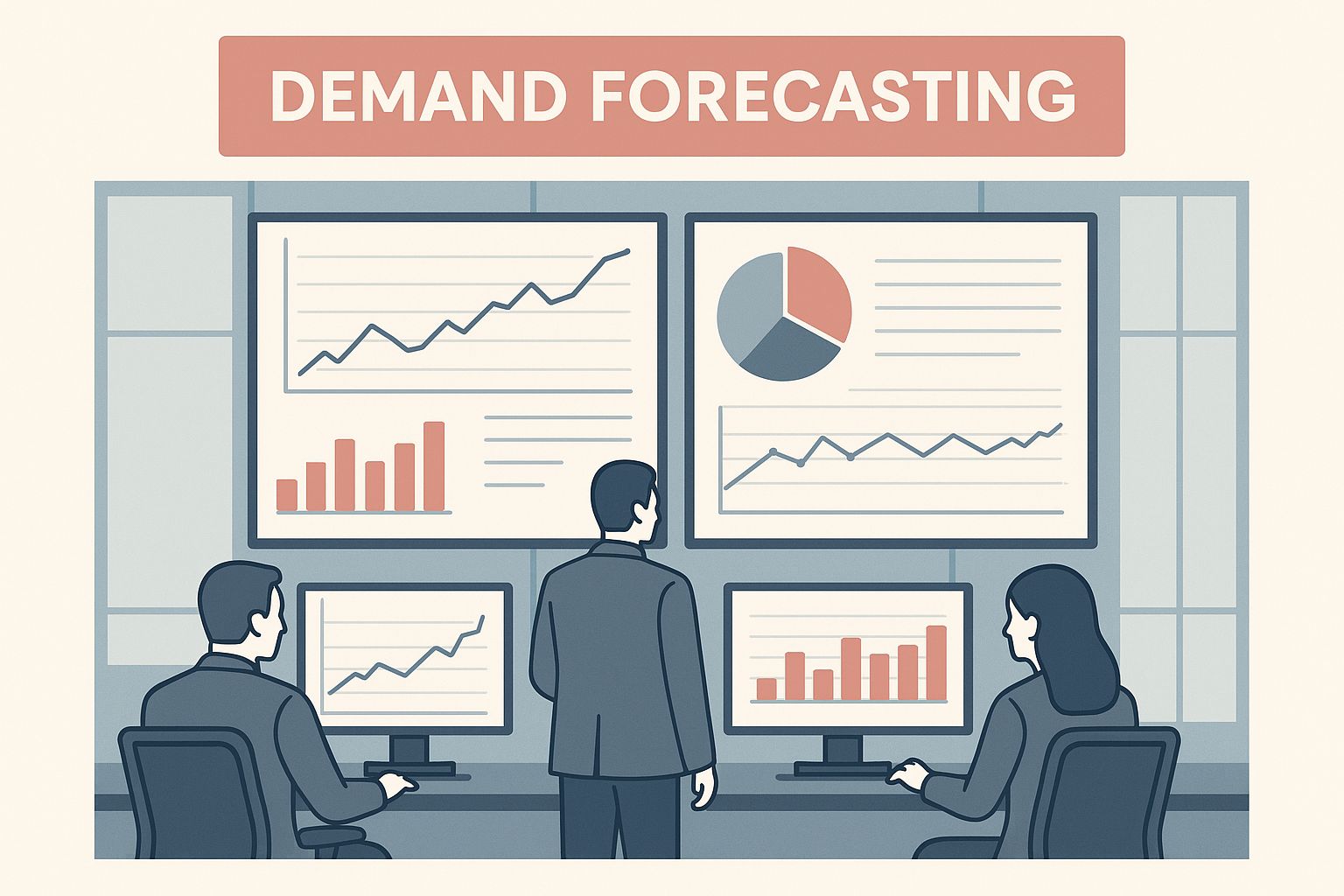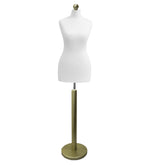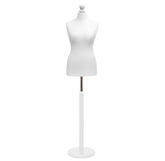Best Practices for Inventory Management: Master Efficient Strategies
The best practices for inventory management aren’t just a single technique; they’re a blend of data-driven forecasting, strategic stock categorisation, and smart technology. Imagine running a busy restaurant kitchen. You need the right ingredients, in the right amounts, at precisely the right time. Get it wrong, and you either can't serve your customers or end up with a pile of wasted food.
Mastering these principles turns inventory from a constant logistical headache into one of your biggest competitive advantages.
Why Modern Inventory Management Is So Important
The days of relying on a clipboard and manual counts are long gone. In today's fast-moving market, that old approach just can't keep up. A disorganised stockroom inevitably leads to frustrated customers, lost sales, and cash needlessly tied up in products that just aren't selling.
Think of effective inventory management as the engine that drives your entire operation. It has a direct impact on everything from your cash flow to whether a customer decides to shop with you again.
To really get a handle on this, understanding the Top Inventory Management Best Practices is a must. It's about so much more than just counting what you have; it's about building a supply chain that's both responsive and resilient.
Core Pillars of a Winning Strategy
A truly modern approach is built on a few core pillars that all work together. When you get these right, you gain a crystal-clear, accurate view of your stock at all times.
- Demand Forecasting: This is about looking at your past sales data to make intelligent predictions about what customers will want in the future. It's the key to preventing both frustrating stockouts and costly overstocking.
- Smart Categorisation: Not all products are created equal. Organising them based on their value and how quickly they sell (using methods like ABC analysis) helps you focus your energy where it matters most.
- Technology Integration: Using the right software and tools automates tracking, cuts down on human error, and gives you real-time data to make better, faster decisions.
To give you a clearer picture, this table breaks down these core pillars and what they achieve.
Core Pillars of Modern Inventory Management
| Practice | Primary Goal | Key Business Benefit |
|---|---|---|
| Demand Forecasting | Predict future customer demand with accuracy | Prevents stockouts and overstocking, maximising sales and minimising waste. |
| Smart Categorisation | Prioritise inventory based on its value and sales velocity | Focuses management efforts on high-impact products, improving efficiency. |
| Technology Integration | Automate tracking and provide real-time data insights | Reduces manual errors, improves accuracy, and enables faster decision-making. |
Getting these elements right unlocks a powerful combination of benefits for your business.
Good inventory control directly reduces your carrying costs, minimises the risk of stock becoming obsolete, and dramatically improves how accurately you can fulfil orders. This trio of benefits is crucial for staying profitable and protecting your brand's reputation in a crowded market.
This is where data visualisation comes into play. Analysts use it to spot trends and make informed decisions, like forecasting demand to stay ahead of the curve.

The image above perfectly illustrates how different data points are connected to inform strategy, turning raw numbers into intelligence you can actually use.
Ultimately, bringing these pillars together allows your business to become far more agile and customer-focused. For retailers, this even connects to how products look on the shop floor. After all, what’s the point of having the right stock if it isn't presented well? This is a concept we explore in our guide on https://www.displayguru.co.uk/blogs/news/visual-merchandising-guidelines, which can help you turn that well-managed inventory into actual sales.
Forecasting Demand to Prevent Stockouts

Predicting what your customers will want to buy, and when, is the bedrock of smart inventory management. Think about it like planning a huge outdoor festival. You wouldn't just take a wild guess at how many people will show up. You’d look at last year's attendance, ticket pre-sales, and maybe even the weather forecast. Applying that same forward-thinking logic to your business is one of the most powerful things you can do.
This isn’t about guesswork; it's about shifting your entire operation from being reactive to being strategic. Instead of scrambling to reorder a popular item after you've already sold the last one, you can see the demand coming and have the right products waiting. This does more than just prevent a lost sale—it builds a reputation for reliability and keeps your customers happy.
Analysing Past Sales to Predict Future Needs
Your own sales history is a goldmine. Buried in that data are clear patterns that can tell you a remarkable amount about what's coming next. To start digging, focus on two key indicators that have a direct impact on your stock levels.
- Trend Analysis: This is about looking at the bigger picture. By examining sales data over a longer stretch, say the last 12 months, you can see the general direction a product is heading. Is a particular style of garment rail selling more and more each quarter? That’s an upward trend, and you need to adjust your ordering to match its trajectory.
- Seasonal Forecasting: Many products have demand cycles that are as predictable as the seasons themselves. A retailer selling dressmaker's dummies, for example, will almost certainly see a sales spike just before fashion school terms begin. Pinpointing these cycles lets you build up stock before the rush and then scale back when things quieten down. Knowing exactly when to stock up on a popular cream torso bust with a gold wood base can be a game-changer.
Calculating Safety Stock and Reorder Points
Of course, even the most meticulous forecast can’t predict everything. A sudden supplier delay or an unexpected mention on social media can wipe out your stock in a flash. That’s where your safety stock and reorder points come in to provide a crucial buffer.
A reorder point is the stock level that tells you, "It's time to order more." Your safety stock is the extra inventory you keep on hand just in case, covering you for unexpected demand or delays. They work together to create an automated safety net against running out.
It’s just like the fuel gauge in your car. You don't drive until the engine sputters to a halt before you think about refuelling. The little warning light—your reorder point—pings you to take action while you still have a reserve in the tank—your safety stock—to comfortably get you to the next petrol station. Calculating these figures properly is what keeps your business running smoothly, no matter what surprises come your way.
Prioritising Your Stock with ABC Analysis
Let’s be honest: not all of your stock is created equal. You’ve got your best-sellers that practically fly out the door, and then you have those other items that sell, well, eventually. A common mistake is treating them all the same, but one of the smartest things you can do for your business is to start prioritising.
This is where a technique called ABC analysis comes into play. It’s a straightforward but powerful way to categorise your stock based on how much value it brings to your business. Think of it like your personal finances: you naturally pay a lot more attention to your mortgage payment than your daily coffee habit. Both are expenses, but one clearly has a much bigger impact on your financial health.
By applying that same logic to your inventory, you can focus your time, money, and energy where it truly counts and will make the biggest difference to your bottom line.
How to Categorise Your Products
The ABC method breaks your inventory down into three simple categories. It's built on a classic business concept called the Pareto Principle, which you might know as the 80/20 rule. In the world of inventory, this means that a small number of your items—your 'A' products—are responsible for the vast majority of your sales value.
-
Category A: These are your superstars. They typically make up just 10-20% of your total inventory items but bring in a whopping 70-80% of your revenue. These products need your full attention, with tight controls and frequent monitoring.
-
Category B: These are your solid, middle-of-the-road items. They're important and sell steadily, but they don't demand the same level of constant watchfulness as your A-list products.
-
Category C: This is the bulk of your inventory, often more than 50% of your total stock, but it only accounts for around 5% of your annual sales value. These are your slow-moving, low-value items that are still necessary to have on hand.
Once you've sorted your stock like this, you can build a tiered management strategy. A-items might get a look-in every day, B-items reviewed weekly, and C-items checked just once a month. It’s all about working smarter, not harder.
For a business like Display Guru, a best-selling female mannequin would be a classic A-item. On the other hand, a very specific type of clamp or a less common accessory would likely fall into the C category.
The Practical Benefits of This Approach
With your inventory neatly categorised, you can start managing it more intelligently. For your high-value A-items, you’ll want to implement meticulous stock control, conduct frequent cycle counts, and keep a very close eye on sales forecasts to ensure you never run out. A stockout on one of these is a major missed opportunity.
For your C-items, you can afford to be more relaxed. Ordering larger quantities less often can cut down on admin and delivery costs. This simple act of prioritisation protects your most valuable assets without you having to waste precious time and resources on the small stuff.
Improving Accuracy with Audits and Stock Rotation
Even the sharpest forecasting and smartest categorisation mean very little if your inventory data isn't accurate. Think of it this way: your stock records are only as reliable as their last check-up. Just like a car needs a regular MOT to stay roadworthy, your stock needs routine audits and proper rotation to keep it in good health.
These aren't just tick-box exercises; they're the foundational practices that build trust in your data and stop small errors from spiralling into costly problems.
Let's start with stock rotation. The classic example is a grocer managing their milk supply. They always push the oldest cartons to the front, making sure they sell first to prevent spoilage. That, in a nutshell, is the First-In, First-Out (FIFO) method. For any business with products that have a shelf-life or are subject to trends and design updates, FIFO is non-negotiable. It’s all about clearing older stock before it loses its value or becomes obsolete.
For instance, a particular mannequin design, like a trendy brown flower on a black torso dummy, could be replaced by a newer pattern next season. Using FIFO ensures you sell through the original design first, avoiding a pile-up of last year's model.
Keeping Your System Honest with Audits
So, how do you confirm your records match reality? Through an inventory audit. This is simply the process of physically counting your stock and comparing that number to what your software says you have. It's the moment of truth that reveals any discrepancies, whether they're from theft, damage, or a simple data entry mistake. Catching these issues early is key.
There are two main ways to go about this:
- Full Physical Inventory: This is the big one—a complete, wall-to-wall count of every single item you hold. It’s incredibly thorough, but it's also highly disruptive. You’ll likely have to halt all operations for at least a day to get it done.
- Cycle Counting: This is a much more modern and manageable approach. Instead of a massive annual count, you count small, specific sections of your inventory on a rotating schedule throughout the year.
Cycle counting turns auditing from a once-a-year headache into a continuous, low-impact process. By regularly checking small segments of your stock, you can spot and fix inaccuracies almost as soon as they happen. The result is a consistently reliable inventory count, all year round.
This is where your ABC analysis comes back into play. You might decide to count your high-value 'A' items every month, your 'B' items quarterly, and your slower-moving 'C' items just twice a year. This focuses your effort where it matters most, making your audits far more efficient.
Ultimately, combining a disciplined stock rotation policy like FIFO with a regular cycle counting programme is the only way to operate. It protects the value of your inventory, guarantees the integrity of your data, and gives you the solid foundation needed to make confident, profitable decisions.
6. Using Technology to Optimise Your Stock
https://www.youtube.com/embed/JpDKpc1NQVc
Solid forecasting and smart categorisation are your foundations, but technology is what brings modern inventory management to life. Let's be honest, manual spreadsheets and sheer guesswork just don't cut it anymore against the speed and accuracy of today's systems.
Think of the right tech as the central nervous system for your entire supply chain. It connects every moving part and lets you make intelligent, data-backed decisions on the fly. We're moving far beyond simple record-keeping; these tools automate the dull stuff, get rid of costly human errors, and give you a crystal-clear view of your stock that was once impossible.
This isn't just about being more efficient. It's about building a business that can roll with the punches. In fact, a 2025 survey found that 73% of UK companies said supply chain problems hit their operations hardest, forcing them to get serious about tracking their inventory.
The Impact of AI and Real-Time Tracking
Artificial Intelligence (AI) has completely changed the game for demand forecasting. AI algorithms can sift through enormous amounts of data—past sales, market trends, seasonal shifts, even the weather—to predict what customers will want with incredible accuracy. This means no more frustrating stockouts during your busiest periods and less cash needlessly tied up in products that just won't shift.
At the same time, real-time tracking gives you that all-important visibility.
- RFID (Radio-Frequency Identification) Tags: These tiny electronic tags let you track individual items in an instant. Imagine knowing your exact stock count with the press of a button, making laborious manual counts a thing of the past.
- Barcode Scanners: A familiar sight in any modern business, these tools simplify everything from checking in new deliveries to ringing up sales, making sure your stock data is always accurate.
For a business selling something specific, like a female dressmakers dummy with a gold wood base, this kind of precision is crucial. It guarantees that when a fashion student or a boutique owner places an order, you know for certain it’s in stock and can be dispatched immediately.
Comparing Inventory Management Technologies
Choosing the right technology can feel daunting, but it helps to understand what each tool is designed to do. The table below breaks down some of the most common options and their direct impact on a business.
| Technology | Primary Function | Key Business Impact |
|---|---|---|
| Barcode Scanners | Automate data entry for stock movements | Reduces manual errors and speeds up checkout and receiving |
| RFID Tags | Provide real-time, item-level tracking without line-of-sight | Enables instant stock takes and drastically improves accuracy |
| Inventory Management Software | Centralise all stock data and automate key processes | Provides a single source of truth for better decision-making |
| Artificial Intelligence (AI) | Analyse data to predict future demand and trends | Minimises stockouts and overstocking, optimising cash flow |
Each of these technologies solves a different piece of the puzzle. The goal is to build a system where they work together, feeding you the insights needed to run a tight ship.
Building an Operation Fuelled by Data
When you start weaving these technologies together, you create a powerful, data-rich environment. Every scan, every sale, and every shipment feeds into your central system, painting a complete picture of your inventory's journey from supplier to customer.
Technology transforms inventory from a logistical headache into a strategic asset. By giving you accurate, real-time data, it allows you to be proactive rather than reactive, handing you a serious competitive edge.
This data allows you to make much smarter decisions, from redesigning your warehouse layout for faster picking to fine-tuning your entire purchasing strategy.
The automation doesn't stop at simple tracking, either. For a deeper look at how this works in practice, it’s worth reading about automating inventory management with Robotic Process Automation. This kind of system can handle routine jobs like reordering stock and generating reports, which frees up your team to focus on growing the business.
Ultimately, using the right technology is no longer a "nice-to-have"—it's an absolute must for building an efficient, resilient, and customer-focused operation that can thrive in a fast-moving market.
The Rise of Warehouse Automation

It’s not just the software behind the scenes that’s changing; a physical transformation is taking place on the warehouse floor itself. Automation is moving from our screens into the stockroom, offering a powerful solution to some of the biggest headaches in logistics—from labour shortages and human error to the relentless pressure for faster delivery.
This isn't some far-off, futuristic concept anymore. It’s rapidly becoming the standard for any business serious about building a competitive and scalable operation. Picture a warehouse where robots glide silently between aisles, handling repetitive tasks with relentless speed and precision. This frees up your skilled team to focus on the complex, value-added work that truly needs a human touch.
Key Automated Systems and Their Impact
Two main technologies are spearheading this shift: Automated Storage and Retrieval Systems (AS/RS) and robotics. Both directly tackle the core goals of inventory management by making everything faster, more accurate, and more efficient.
- Automated Storage and Retrieval Systems (AS/RS): Think of these as intelligent, high-density libraries for your stock. A network of cranes and shuttles automatically stores and retrieves products, making brilliant use of vertical space. You can dramatically increase your storage capacity without the expense of a bigger building.
- Autonomous Mobile Robots (AMRs): Unlike a fixed conveyor belt, AMRs are smart little vehicles that navigate the warehouse floor on their own. They can be sent to move stock from receiving to its storage spot or, even better, bring the right items directly to a human packer. This simple change almost completely eliminates wasted walking time.
For a business like Display Guru, this could look like an AS/RS system managing thousands of display components while AMRs deliver specific products, like a size 12-14 dressmakers dummy with a silver wood base, straight to the packing station.
The real power of automation lies in its consistency. A robot never gets tired, distracted, or has an off day. It performs its task with the same level of accuracy on its thousandth repetition as it did on its first—a game-changer for maintaining perfect inventory integrity.
The Growing Importance of Automation in the UK
Adopting these technologies is far more than a passing trend; it represents a major industrial shift. The warehouse automation market in the UK was valued at around $1 billion in 2020 and was projected to grow at a compound annual rate of 24% through 2025. This explosion shows just how critical robotics have become for businesses needing to improve their speed and precision. Discover more insights on the UK warehouse automation market on Statista.com.
Your Inventory Questions, Answered
Taking the first steps towards a proper inventory system can feel like a huge task, but it doesn't have to be. Let's break down some of the most common questions we hear from business owners who are just getting started.
I'm a Small Business. Where on Earth Do I Start?
The best place to start is with one simple goal: visibility. After all, you can't manage what you can't see. Your first move should be a full physical count of every single item you have in stock. This gives you a clear, honest baseline to work from.
Once you know what you have, implement a simple sorting method like ABC analysis. This is a game-changer because it instantly shows you which products are your bread and butter, helping you focus your energy where it matters most instead of getting bogged down in the details.
How Do I Pick the Right Inventory Software?
Choosing software really boils down to your specific needs and where you see your business going. The key is to find a system that can grow with you, not one you'll outgrow in a year.
Look for a few core features that will make your life easier:
- Real-time tracking so you always have up-to-the-minute stock levels.
- Barcode scanning to slash the number of manual data entry errors.
- Automated reorder point alerts to stop you from running out of popular items.
- Simple reporting tools that let you actually understand your sales trends.
My advice? Steer clear of overly complex, feature-packed systems at the beginning. Focus on finding a user-friendly platform that nails the fundamentals.
What’s the Easiest Way to Get Started with Forecasting?
Forecasting sounds more intimidating than it is. You already have the most crucial tool at your fingertips: your past sales data. Start by pulling at least six to twelve months of sales history from your till or accounting software.
The simplest and most effective way to begin is to focus on your top 10 best-selling products. Look at their sales patterns month by month. Are there obvious seasonal spikes or steady trends? This initial analysis will give you the confidence to make your first informed predictions.
As you get the hang of it, you can start applying these same techniques across more of your product range. It’s all about building your skills and accuracy over time.
Ready to show off your perfectly managed stock? Display Guru provides the professional-quality mannequins, garment rails, and display solutions you need to make your products shine. Explore our collection at https://www.displayguru.co.uk.








